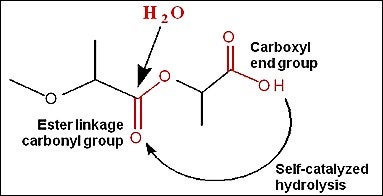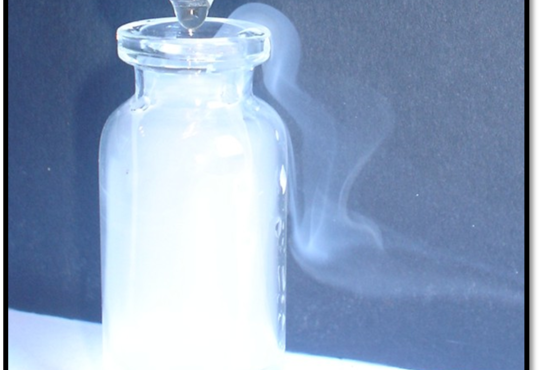I first took notice of PLA (polylactide or poly-lactic acid) polymers in the summer of 2009 while vacationing at our family cottage. There, most evenings included a campfire, some conversation, occasionally even a song, but on this night the peaceful sounds of a summer evening came to an abrupt halt with an ear-splitting crackle. The noise drew the attention of everyone (probably the neighbours as well), who turned in unison to discover my brother-in-law opening a bag of chips.
Anyone who has eaten this snack at this time may recall the loud crackly sound which came from the SunChips© newly-released 100% compostable packaging. The noisy package, despite its environmental advantage, created such negative consumer feedback (including a Facebook page entitled “Sorry but I Can't Hear You over This Sun Chips Bag”1) that SunChips’ manufacturer, Frito-Lay2, pulled the plug on the bag for all but one of its flavours in the fall of the same year. In Canada, the bags remained despite the noise.3 Scientific curiosity piqued, I felt compelled to find out more about this very noticeable package. It didn't take long to discover that the material was polylactide, a polymer derived from lactic acid. Because it is manufactured from plant materials, PLA is the subject of a great deal of research and development as a replacement for petroleum-based plastics. In addition to being produced from renewable resources, PLA can be melted and molded into a variety of packaging types, but it has the distinct advantage of being biodegradable and compostable.4 The polylactide used for the SunChips bag is produced by NatureWorks5 in Blair, Nebraska, and marketed under the trade name Ingeo (Ing – ingredients, geo – earth) in a sustainable process. Corn sugars (glucose) are broken down through fermentation by micro-organisms into lactic acid, a carboxylic acid, according to the following reaction, producing two molecules of either L- or D-lactic acid:
C6H12O6 → 2 CH3CHOHCOOH
Two lactic acid molecules link to form a cyclic dimer called a lactide, which then undergoes a ring-opening polymerization reaction to form the PLA polymer.
(2 + n)

Fig. 1. Lactide can be polymerized to polylactic acid6.
The original dimer units can be LL, DD or DL (meso-), depending on the orientation of the original lactic acid molecules, and the final polylactide properties will be affected by the proportions of these subunits. Although microorganisms produce primarily L-lactic acid, almost all PLA contains some amount of the meso-lactide due to impurities in the production process.7 The final PLA polymer exhibits structural properties that make it comparable to many types of packaging plastics currently in use. It can be injection molded, sheet extruded, blow molded, thermoformed and formed into a film. In recent years, PLA polymers have gained limited use in replacing polyethylene (PE), polypropylene (PP) and polyethylene terephthalate (PET) — all of which are petrochemical based plastics — as short term food packaging materials, disposable cups and lids, clamshell packs, bags and plastic wraps.4 The PLA bags originally marketed by Frito-Lay were tested to be “industrially compostable”, meaning that under carefully controlled composting conditions they would degrade fully into non-toxic components within the soil. The degradation of PLA is primarily by hydrolysis and cleavage of the ester linkages of the polymer with exposure to moisture resulting in low molecular weight polymer fractions.

Fig. 2. Degradation of PLA occurs through hydrolysis and breakdown of the ester linkage.8
Subsequently, these smaller polymer molecules can be used by microorganisms yielding carbon dioxide, water and humus.5 Although the PLA packaging was marketed as compostable, the limitations of most municipal waste systems means that the great majority of these packages will end up in landfills, where they will remain virtually unchanged for perhaps hundreds of years.9 So although Frito-Lay deserves credit for trying to make a more environmentally friendly product, they might have been better served marketing the fact the packaging is a product of renewable resources with lower energy costs, rather than how the packaging degrades.
But why was that SunChips bag so noisy? Well, it turns out that the problem was not the material, but rather the manufacturing. A standard potato chip bag is composed of three layers: an outer printed layer, an inner protective layer and an adhesive layer that holds the other two together. By switching to a more rubbery adhesive layer, Frito-Lay found that the bag noise was decreased to that of most other chip bags while still being 100% compostable.10 This improved packaging silently made its debut in 2011, but only on SunChips original flavor in the US, the lone variety that didn't return to plastic after the original backlash.
In Canada, we can go back to enjoying our campfires with snacks in peace.
References (accessed January 2014)
- http://www.facebook.com/pages/SORRY-BUT-I-CANTHEAR-YOU-OVER-THIS-SUN-CHIPS-BAG/116706515038289
- http://www.fritolay.com/
- http://grist.org/article/food-2010-11-01-sunchips-bag-not-too-
noise-for-canadians/ - R. Rasal, D.E. Hirt, Improving the properties of polylactic acid, Society of Plastics Engineers, Plastics Research Online. http://www.4spepro.org/pdf/001583/001583.pdf
- NatureWorks LLC, http://www.natureworksllc.com/
- http://en.wikipedia.org/wiki/Lactide
- R. Auras, B. Harte and S. Selke, (2004), An Overview of Polylactides as Packaging Materials. Macromolecular Bioscience, 4: pages 835–864. doi: .1002/mabi.200400043
- http://www.ytca.com/biodegradable_plastics_and_composites
- Environment and Plastics Industry Council, A Council of the Canadian Plastics Industry Association, Mississauga, Ontario http://www.bpiworld.org/resources/Documents/EPIC%20Position%20on%20Biodegradability%20and%20Landfills.pdf
- https://www.fastcompany.com/1731385/sunchips-silences-its-%20earsplitting-bio-bag






